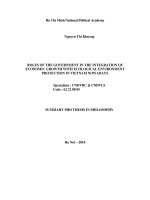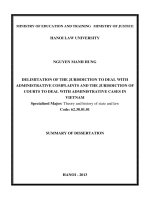The influence of institutional quality of firm size and number of non state firm at province level in vietnam
Bạn đang xem bản rút gọn của tài liệu. Xem và tải ngay bản đầy đủ của tài liệu tại đây (1.13 MB, 56 trang )
UNIVERSISTY OF ECONOMICS
HO CHI MINH CITY
VIET NAM
INSTITUTE OF SOCIAL STUDIES
THE HAGUE
THE NETHERLANDS
VIET NAM – NETHERLANDS
PROGRAMME FOR M.A IN DEVELOPMENT ECONOMICS
THE INFLUENCE OF INSTITUTIONAL QUALITY
ON FIRM SIZE AND NUMBER OF NON – STATE FIRMS
AT PROVINCE LEVEL IN VIETNAM
By
TRINH MINH HAN
MASTER OF ARTS IN DEVELOPMENT ECONOMICS
HO CHI MINH, November 2017
UNIVERSISTY OF ECONOMICS
HO CHI MINH CITY
VIET NAM
INSTITUTE OF SOCIAL STUDIES
THE HAGUE
THE NETHERLANDS
VIET NAM – NETHERLANDS
PROGRAMME FOR M.A IN DEVELOPMENT ECONOMICS
THE INFLUENCE OF INSTITUTIONAL QUALITY
ON FIRM SIZE AND NUMBER OF NON – STATE FIRM
AT PROVINCE LEVEL IN VIETNAM
A thesis submitted in partial fulfillment of the requirements for the degree of
MASTER OF ARTS IN DEVELOPMENT ECONOMICS
By
TRINH MINH HAN
Academic Supervisor:
Dr. TRUONG DANG THUY
HO CHI MINH, November 2017
ABSTRACT
The relationship between institutions and firm size is now well established. This paper
investigates the influences of the institutional quality of local government on firm size and
number of non – state firms by using the panel data of 52 provinces in Vietnam from the
period 2009 to 2013. We use a unique dataset and ranking of provincial governance
institutions from Vietnam as measure of the institutional quality. We deal with the
endogeneity issue by using the distance from the 17th parallel as the instrument for the
institutions variable. Interestingly, we find no evidences to clarify the relationship between the
institutional quality, firm size and number of non – state firms at province level in Vietnam.
Keywords: institutions, the PCI, average firm size, number of non – state firms.
ACKNOWLEDGEMENT
With completely heart and soul, I would like to manifest my most sincere gratitude to my
supervisor Dr. Truong Dang Thuy. There is nothing more valuable than his instructions and
advice since I was lost in the final stage to finish this program. His spirit and responsibility is
definitely the most memorable and impressive for me even when I am no longer a student of
VNP. After all, Dr. Thuy, I would like to say that thank you so much.
In addition, I thank my family, friends, VNP officers so much for supporting me to complete
this program.
ii
TABLE OF CONTENTS
ABSTRACT.......................................................................................................................................................... II
ACKNOWLEDGEMENT ....................................................................................................................................... II
TABLE OF CONTENTS ........................................................................................................................................III
ABBREVIATIONS ............................................................................................................................................... V
LIST OF FIGURES .............................................................................................................................................. VI
LIST OF TABLES ............................................................................................................................................... VII
CHAPTER ONE: INTRODUCTION ......................................................................................................................... 1
1.1 PROBLEM STATEMENT ................................................................................................................................... 1
1.2 SCOPE AND OBJECTIVE OF RESEARCH ............................................................................................................ 2
1.3 RESEARCH HYPOTHESES ................................................................................................................................. 3
1.4 THESIS STRUCTURE ......................................................................................................................................... 3
CHAPTER TWO: LITERATURE REVIEW ................................................................................................................ 4
2.1 THE RELATIONSHIP BETWEEN INSTITIONS AND FIRM SIZE ............................................................................. 4
2.2 THE FIRM SIZE AND THE EMPLOYEE – WEIGHTED AVERAGE FIRM SIZE .......................................................... 8
2.3 HOW TO MEASURE INSTITIONAL QUALITY ................................................................................................... 10
2.4 OTHER STATE VARIABLES.............................................................................................................................. 12
2.5 THE RELATIONSHIP BETWEEN INSTITUTIONS AND NUMBER OF FIRMS ....................................................... 13
CHAPTER THREE: METHODOLOGY AND DATA ................................................................................................. 16
3.1 DATA SOURCES AND CHARACTERISTICS ....................................................................................................... 16
3.1.1 DATA SOURCES ..................................................................................................................................... 16
3.1.2 EMPLOYEE – WEIGHTED AVERAGE FIRM SIZE and NUMBER OF FIRMS ............................................... 16
3.1.3 MEASURE OF INSTITUTIONS ................................................................................................................. 18
3.1.4 OTHER CONTROL VARIABLES ................................................................................................................ 21
3.2 ENDOGENEITY ISSUE .................................................................................................................................... 21
3.3 MODEL SPECIFICATION ................................................................................................................................. 23
CHAPTER FOUR: RESEARCHING RESULT ........................................................................................................... 26
4.1 STATISTIC ANALYSIS ...................................................................................................................................... 26
iii
4.1.1 DESCRIPTIVE STATISTICS ....................................................................................................................... 26
4.1.2 BIVARIATE ANALYSIS ............................................................................................................................ 29
4.2 RESULT.......................................................................................................................................................... 34
CHAPTER FIVE: CONCLUSION ........................................................................................................................... 39
5.1 CONCLUSION ................................................................................................................................................ 39
5.2 LIMITATION .................................................................................................................................................. 40
5.3 SUGGESTION FOR FUTURE RESEARCHES ...................................................................................................... 40
REFERENCES .................................................................................................................................................... 41
APPENDICES .................................................................................................................................................... 44
iv
ABBREVIATIONS
AFS
Average firm size
EWAS
Employee – weighted average firm size
FE
Fixed effects
GDP
Gross Domestic Product
GSO
General Statistics Office
IV
Instrumental variable
Max
Maximum
Min
Minimum
Obs
Observation
OLS
Ordinary least squares
PCI
Provincial Competitiveness Index
RE
Random effects
Std. Dev
Standard deviation
VCCI
Vietnam Chamber of Commerce and Industry
v
LIST OF FIGURES
Figure 1: Scatter plot of the effect of PCI, Market size, GDP per capita, Schooling on
Employee – weighted average firm size. .................................................................................. 30
Figure 2: Scatter plot of the effect of PCI, Market size, GDP per capita, Schooling on average
firm size. ................................................................................................................................... 31
Figure 3: Scatter plot of the effect of PCI, Market size, GDP per capita, Schooling on number
of non – state firms. .................................................................................................................. 32
Figure 4: Scatter plot of the effect of Distance, Market size, GDP per capita and Schooling on
PCI index. ................................................................................................................................. 33
vi
LIST OF TABLES
Table 1: Descriptive statistics ................................................................................................... 26
Table 2: Correlation of variables .............................................................................................. 29
Table 3: What determines firm size? ........................................................................................ 34
Table 4: What determines firm size? (using IV)....................................................................... 36
Table 5: What determines number of non – state firms? .......................................................... 37
Table A 1: List of Vietnamese provinces ................................................................................. 44
Table A 2: Data sources and definition of variables ................................................................. 45
Table A 3: Top five leading provinces of PCI Ranking from 2009 to 2013. ........................... 47
vii
CHAPTER ONE: INTRODUCTION
1.1 PROBLEM STATEMENT
A firm always has to deal with issues such as the mobilization of resources for
investment, the administration of performance, the resolution of conflicts among different
parties, and these ones should be accomplished internally. However, the legal system could
influence on those problems, and as a result, the optimal size of firms might also reply on the
development of institutions in each country.
In various studies that exploit either cross – country variation or single country
variation have investigated the influences of institutional quality on firm size. Kumar, Rajan,
and Zingales (henceforth KRZ) (2001) concluded that higher efficient legal systems lead to
larger firm sizes across thirteen European countries, the effect are stronger for industries
where physical assets are less important. In Mexico, Laeven and Woodruff (2007) found that
the positive relationship between average firm size and judicial efficiency, this link is more
prevalent for proprietorships than for corporations. Beck et al. (2006) had similar result when
they used firm – level data on the largest industrial firms in forty - four countries.
Based on those previous researches, this paper will investigate the relationship between
the local governance and entrepreneurs in Vietnam. Interestingly, this country has a
homogenous political system and government structure, but economic performances is
substantially different among provinces (VNCI – VCCI, 2005).
Vietnam is a nation with more than ninety million persons, a developing country
organized into sixty - three provinces. By launching the renovation reforms (Doi moi) in 1986,
Vietnam’s GDP per capita increases from around 100$ to over 2000$ by the end of 2014
within a quarter of a century, and the poverty rate diminishes from 50% in the early 1990s to
3% in 2015 (World bank, 2015). The story may continue to follow the positive direction, but
unfortunately, it does not.
In recent years, Vietnamese economics has revealed many troubles: the public debt is
too high, the population aging, the polluted environment, the exhausted natural resources,
1
middle income trap… After a long period of renovation reforms, Vietnam just has
approximately a half of a million enterprises, and remarkably, the size of firm tends more and
more small, come to extremely small1.
Many action programs are addressed by the central government of Vietnam to expound
the economics restructuring endeavors. By improving the business environment, increasing the
efficiency of governmental operations and administrations, eliminating the business
constraints… policy makers desire to achieve the target having a million enterprises in 2020.
Even though this target is quite modest in comparing with population scale, the result of this
one is still hard predictable.
The Provincial Competitiveness Index (PCI) is an annual ranking of economic
governance in Vietnam’s sixty-three provinces produced by the Vietnam Chamber of
Commerce and Industry (VCCI). Fundamentally, the VCCI gathers the opinions of about
7,000 domestic private firms regarding economic governance in their provinces.
The PCI has the intention to improve the efficiency of administration of local
governments by putting them into a competition with each other, though at the beginning, this
index lacks of their attention. When the people and enterprise society have more and more
interest in this index, they are no longer ignore it, the competition becomes the real one among
sixty-three provinces and the PCI has proved its meaning.
By clarifying the influences of institutions on economic outcomes through the lens of
the PCI index and firm size, this paper presents strong arguments to policy makers to improve
the business environment that is one of primary growth rate constrains of Vietnam.
1.2 OBJECTIVE AND SCOPE OF RESEARCH
This paper investigates the influences of the quality of municipal institutions on firm
size and number of non – state firms. In order to acquire that, this one uses a unique dataset
and ranking of provincial governance institutions from Vietnam – The PCI - to measure the
1
/>
2
quality of institutions. The final findings will support directly central and local government to
make policies and to complete their strategic objectives.
The dataset used in this paper comes from fifty – two provinces with the period from
2009 to 2013. With every province, the respective PCI data and the distance from it to the 17 th
parallel are also gathered.
1.3 RESEARCH HYPOTHESES
H1: The PCI index is associated with average firm size.
H2: The higher PCI index has a positive effect on number of non – state firm.
1.4 THESIS STRUCTURE
The thesis comprises five chapters. Chapter two reviews the literature about
institutions, firm size, number of firms and the relationship among them. This one also
illustrates the method to measure variables and empirical results. Chapter three discusses the
dataset: data sources and characteristics, the approach of estimations employed in this study.
Chapter four unveils the finding from the scope data of 52 provinces/ cities in Vietnam. The
last one presents conclusions, recommendations and the limitations of this paper.
3
CHAPTER TWO: LITERATURE REVIEW
This chapter presents empirical results of prior researchers when they investigate the
influences of institutional quality on firm size and number of firm. In addition, this chapter
discusses techniques to measure the quality of institutions and firm size.
2.1 THEORY OF FIRM
According to Ronald Coase (1937): “people begin to organize their production in firms when
the transaction cost of coordinating production through the market exchange, given imperfect
information, is greater than within the firm”.
He stated that a firm’s interactions with the market may not be under its control (for example
because of sales taxes), but its internal allocation of resources. He wondered why alternative
methods of production such as price mechanism or economic planning, could not either
achieve all production, hence either firms use internal prices for all their production, or one
big firm runs the entire economy. He augured that the main reason to establish a firm is to
avoid some of the transaction costs of using the price mechanism. These include discovering
relevant prices (which can be reduced but not eliminated by purchasing this information
through specialists), as well as the costs of negotiating and writing enforceable contracts for
each transaction (which can be large if there is uncertainty).
If a firm operated internally under the market system, many contracts would be required (for
instance, even for producing a pen or delivering a presentation). In contrast, a real firm has
very few (though much more complex) contracts, such as defining a manager’s power of
direction over employees, in exchange for which the employee is paid.
He noted that government measures relating to the market (sales taxes, rationing, price
controls) tend to increase the size of firms, since firms internally would not be subject to such
transaction costs. Thus, Coase defined the firm as “the system of relationships which comes to
existence when the direction of resources is dependent on the entrepreneur”.
The question then arises of what determines the size of firms, why does the entrepreneurs
organize the transactions they do, why no more or less? Since the reason for the firm’s being is
4
to have lower costs than the market, the upper limit on the firm’s size is set by costs rising to
the point where internalizing an additional transaction equals the cost of making that
transaction in the market. In practice, diminishing returns to management contribute most to
raising the costs of organizing a large firm, particularly in large firms with many different
plants and differing internal transactions (such as conglomerate), or if the relevant prices
changes frequently.
Ronald Coase concluded that the size of firms is dependent on the costs of using the price
mechanism, and on the costs of organization of other entrepreneurs.
2.2 THEORY OF INSTITUTIONS
There is now considerable evidence that “institutions” are important determinants of
economics. Douglass North, for example, emphasized in equal measure the importance of
“contracting institution”, enabling private contracts between citizens, and “property rights
institutions”, protecting the property rights of citizens against rulers. Despite the importance of
these questions for the study of long – run economic performance, there has been relatively
little work investigating which types of institutions matter more and for which economic
outcomes. This paper offers a step in that direction.
Acemoglu and Johnson (2005) studied contracting institutions with the legal formalism
measure of Djankov et al., the procedural complexity necessary to collect on a nonpaying
commercial debt, and the number of procedures necessary to collect on such a debt. For
property rights institutions, they used various measures of constraints on government power
and protection of property rights. Their identification strategy was to exploit differences in the
historical experiences of former European. In this sample, there are strong and distinct first –
stage relationships between legal origin and various measures of contracting institutions on the
one hand and between colonization strategy and property rights institutions on the other. Using
this multiple instrumental variables strategy, they found robust evidence that property rights
institutions have a major influence on long – run economic growth, investment, and financial
development, while contracting institutions appear to affect the form of financial
5
intermediation but have a more limited impact on growth, investment, and the total amount of
credit in the economy.
Their conjecture is that individuals can structure contracts to reduce the adverse effects from
contracting institutions, for example, by changing the form of intermediation to reduce the
cost of providing outside finance to firms. Because of these adjustments, the usual effect of
rules governing contracts investment and growth may be relatively limited. In contrast,
because enforceable contracts between the state and individuals are not possible, property
rights institutions constraining arbitrary behavior and expropriation by the state and elites have
more important effects on economic outcomes.
2.3 THE RELATIONSHIP BETWEEN INSTITIONS AND FIRM SIZE
Many researchers have studied the impact of the quality of institutions on firm size,
and almost findings indicate that the existence of positive relationship between them.
Kumar et al (2001) concluded that the quality of institutions is higher, firm size is
greater on average, when they studied in thirteen Western European countries. Moreover, they
also observed the effects of physical assets and human capital on firm size. The outcomes are
physical assets play an important role in the influencing magnitude of judicial systems on firm
size, since the effect of human capital is not obvious.
Gathering the data at firm level of forty – four economics, Beck et al (2006) had the
similar conclusions with Kumar et al ‘s finding, not only with the development of institutions,
but the development of financial intermediaries. Both of them have positive effect on average
firm size.
In Mexico case, Laeven and Woodruff (2007) discovered the existence of positive link
between legal environment and average firm size, when they developed a framework in which
institutions influences eccentricity risks of entrepreneur intending to increase share of his
assets in a single firm. In addition, the quality of legal environment has stronger impact on
proprietorships than that on corporations, and they recommended that the decrease in those
risks should be taken into account.
6
Using the data in Spanish, Fabbri (2010) supposed that firm size will increase and bank
financing will cheaper, when the courts are more efficient. In this paper, Fabbri considered the
trial judgments as a measure of the efficiency of a judicial district, more details, she computed
the length of those ones on average, or the ratio between those trial judgments after a year and
the total number of proceeding judgments. In addition, she argued that the endogeneity issue
of the research was solved due to the influences of firm level decisions on macroeconomics or
the cost of law enforcement are limited.
By researching the influences of institutional efficiency on firm size, those authors
clarify various channels – investment decisions, the employment protection legislation,
transaction cost, credit environment … - through which they affect each other.
Firstly, firm size is affected by the inefficient institutions system through investment
decisions of entrepreneurs, when they will consider carefully risks they have to deal with and
their expected incomes. This could lead to decrease probabilities of investment and growth.
Secondly, the institutions could effect on employment decisions of firms by regulations
of labor force protection law, even though this relationship is not obvious conclusion. The
literature could argue that firm’s performance could be relied on its actual implementation to
adapt this law.
Thirdly, the transaction cost will increase since the quality of contract enforcement is
not good, firms may change uprightly integrating their production procedure, and firm size
will larger.
Next, the inefficiency of formal contract enforcement institutions increases the
subordination of parties on relational contracting, and makes the collaboration of them with
new partner becomes more difficult. However, there is another channel, in which barriers
created by those relational contractions hinder the entrance of new firms, and this channel
could increase the average firm size due to the fact that new firms are usually small in size in
compare with operating firms.
7
Finally, Laeven and Woodruff (2007) or Beck et al (2006) have investigated the impact
of credit market on firm size, when they use private credit as a measure of financial
institutions variable. The idea behind that is more efficient functioning judicial systems,
creditors will be safer, the availability of credit and the contractual terms for potential
borrowers will be increased and enriched, as a consequence, financial constraints to growth for
existing firms will be monitored and eliminated. However, it is hard to state that this link is a
causation relationship: more efficient credit market leads to the increasing of number of new
firms, and because new firms are usually small in size, average firm size would smaller.
In summary, the first two channels indicate the negative relationship between
institutions and average firm size, the third channel proposes a positive one, while the two last
channels are ambiguous.
2.2 THE FIRM SIZE AND THE EMPLOYEE – WEIGHTED AVERAGE FIRM SIZE
Many empirical studies suggested various methods to measure firm size based on the
richness of their dataset.
Kumar et al (2001) suggested three techniques to calculate firm size: value added,
output of firms or the number of employees. In Mexico, Laeven and Woodruff (2007) added
the capital stock as measurement of firm size, along with the number of employees, while
Giacomelli and Menon (2012) proposed to use two methods: the total employment and the
turnover of firms.
The data on distribution of firm size could be released not completely its potential
richness when the average firm size is produced simply by the ratio between total employment
and total number of firms in the country or sector combination. In addition, the simple average
firm size is not able to monitor in the case that a giant firm has dominating share in the sector
it belongs to.
Using data from Enterprises in Europe, Kumar, Rajan and Zingales (2001) computed
the Employee Weighted Average Number of Employees based on Davis and Henrekson’s
suggestion (1997).
8
Davis and Henrekson (1997) suggested another approach to calculate firm size. Firstly,
they computed the ratio between the number of employees and the number of firms in given
bin. Then, this ratio will be controlled by its share on the sector (the ratio between the number
of employees in this bin and the total number of employees in the sector).
The weighted – average firm size of the entire sector is weighted sum of these bin averages.
The formula is:
𝑛
∑
𝑒𝑚𝑝
(
𝑏𝑖𝑛=1
𝑁𝑏𝑖𝑛
𝑒𝑚𝑝
𝑁𝑡𝑜𝑡𝑎𝑙
𝑒𝑚𝑝
)×(
𝑁𝑏𝑖𝑛
𝑓𝑖𝑟𝑚𝑠
𝑁𝑏𝑖𝑛
),
Where:
𝑒𝑚𝑝
𝑁𝑏𝑖𝑛
is the total number of employees reported in the given bin.
𝑒𝑚𝑝
𝑁𝑡𝑜𝑡𝑎𝑙 is the total number of employees in the sector.
𝑓𝑖𝑟𝑚𝑠
𝑁𝑏𝑖𝑛
is the number of firms in the bin.
Laeven and Woodruff used data from Mexican economic census in 1998, followed the
same method of Kumar et al (2001) and Davis and Henrekson (1997) to calculate firm size.
Their data were gathered from plant – level data while many studies producing firm size
distribution use enterprise – level data, however, they argued that almost 100 % of firms in
their dataset are single – establishment, then the issue of plant – level data or enterprise – level
data is no longer matter.
In Italy, Giacomelli and Menon (2012) used two methods to compute average firm size
coming from two data sources: ASIA database and CERVED database. The first one includes
the data at province level: the number of firms, the number of plants, the number of employees
and the distribution of rims and plants by size bins. Based on this dataset, they computed
average firm size followed the method of Kumar et al (2001). In addition, they also observed
9
the influences of institutions on total employment and the number of plants, they argued that
small average firm size maybe come from the high entrepreneurship rate.
Their another method to measure firm size is the turnover by gathering the information
of balance sheet of most corporations in Italy. Based on the second dataset, they computed the
turnover of corporation on average at province level for the two periods 2001 – 2002 and 2008
– 2009. The average turnover for the second period indicates firm size, while the growth rate
between those two periods indicates firms’ growth.
Garcia Posada and Mora Sanguinetti (2013) used two approaches – employee weighted
average and arithmetic average – to measure firm size. While the employee – weighted
average firm size followed Kumar et al (2001) and Davis and Henrekson (1997), another one
was the index aggregated from the information of employment, revenue and total assets. The
dataset used in this paper contained firm – level data for the period 2001 – 2009. One of their
concerns is the impact of inefficiency judicial system on the existence of large firms, and they
argued that while the arithmetic average could not control the situation in which a large
amount of very small firm that account for a very small share of regional economics, the
employee weighted average could do. In addition, the employee – weighted average firm size
could minimize the influences of entry and exit since news firms and exiting firms are usually
much smaller in size than operating ones.
2.3 HOW TO MEASURE INSTITIONAL QUALITY
The second major variable of this study is the institutional quality. With every
circumstance, the author has special approach to measure the quality of institutions.
Laeven and Woodruff (2007) used a survey conducted in 1998 to measure institutional
quality. This survey comprised elements: “(i) the quality of judges, (ii) the impartiality of
judges, (iii) the adequacy of judicial resources, (iv) the efficiency of enforcement of rulings,
(v) the efficiency of judicial administration more generally, (vi) the cost, ease of use, and
completeness of property registries, and (vii) the adequacy of local legislation related to
contract enforcement”, and the institutional quality is the final index computed be averaging
10
those seven element. This survey observed the collection of bank debt from thirty – two courts
in each respective states of Mexico.
Kumar et al (2001) used the database of Business International Corp as a measure of
the quality of institutions. This database is a scale from 0 to 10, in which lower marks indicate
lower level of efficiency and integrity of legal environment.
Desai, Gompers, Lerner (2003) defined corruption as “the misuse of public power for
private benefits, bribing of public officials, kickbacks in public procurement, or embezzlement
of public funds”. They used an index calculated by averaging the corruption marks from given
sources as: “(1) Freedom House Nations in Transit, (2) Gallup International, (3) the Economist
Intelligence Unit, (4) the Institute for Management Development, Lausanne, (5) the
International Crime Victim Survey, (6) the Political and Economic Risk Consultancy, Hong
Kong, (7) the Wall street Journal’s Central European Economic Review, (8) the World Bank
the University of Basel, (9) the World Economic Forum”. From “the Global Competiveness
Report 2000 of World Economic Forum”, they used an index of property right protection as
the second measure to institutions. To measure the efficiency of legal system, they used an
index called the Formalism Index, and they examined how well the legal system functions by
using an index from “the Survey of World Business Environment from the World Bank Group
between 1998 – 2000”.
In Italy, Giacomelli and Menon (2016) suggested a method to measure the efficiency
of contract enforcement at court level as “the average length of first instance civil proceedings
in each court”. This proxy indicates that more requiring time to resolve a conflict of a contract,
the efficiency of contract enforcement will reduce. The database was gathered from the Italian
Ministry of Justice.
The primary variable of legal system efficiency in paper of Beck et al (2006) was: “the
time estimate in calendar days of process of dispute resolution named as contract
enforcement”. Moreover, they also observed the influences of financial development on firm
size, and they computed private credit as their primary variable of financial development.
They defined the private credit as: “the claims of deposit money banks and other financial
11
institutions on the private sector as share of GDP”. Finally, a broad measure of institutional
development named as property rights was also applied in their paper, the approach to produce
it was: “the degree of legal protection of private property and the probability that the
government will expropriate private property”.
In robustness tests, they used other dependent variables such as: “stock of market
development, a survey-based indicator of the efficiency and integrity of the legal system, legal
formalism captures the extent of substantive and procedural statutory intervention legal
systems, and control of corruption is a measure of lack of corruption in government”.
2.4 OTHER STATE VARIABLES
Almost papers controlled for the effect of market size on firm size by using log of
municipal population. In the paper of Laeven and Woodruff, they also included GDP per
capita and education level in states, in which education variables was defined as “the share of
population in each state aged fifteen years and over with at least nine years of schooling
education in 1990”.
In the paper of Kumar et al (2001), they used “log of total employment in the industry
in that country” as their measure of market size, though they argued that maybe existing
causality issue between two variables – average firm size and market size. To deal with this
use, they applied instrument variable method, in which their instruments were: “log of GDP,
the country population and the ratio of exports to GDP”. They also added a measure of human
capital produced by “the average years of schooling in the population over age 25”.
Following the same way, Giacomelli and Menon (2012) included “the share of high
schooling graduates on population as a measure of local human capital”. In addition, they used
municipal population as a measure for their market size variable.
Beck et al (2006) used some variables such as: GDP, GDP per capita, the inflation rate,
the share of trade in GDP to clarify what determines firm size. In which the inflation rate was
a measure of the macroeconomic risks, the share of trade in GDP was produced by the ratio
between the sum of exports, imports with the GDP. They argued that the degree of openness
12
of economies was a determinant influencing on firms’ market power. Finally, they defined
“the rate of gross enrollment in secondary education” as a measure of “the level of human
capital accumulation the economy”.
2.5 THE RELATIONSHIP BETWEEN INSTITUTIONS AND NUMBER OF FIRMS
In Italy case, Giacomelli and Menon (2012) not only observed the relationship between
institutions and firm size, but also the effects of institutions on total employment and the
number of firms. While the poor institutions had negative effect on firm size, their findings
also indicated that this one had negative effect on total employment, but did not have a link
with the number of firms. In detail, they run the similar regressions with four dependent
variables (in logs): “the average plant size, the employee weighted average firm size, the total
number of plants, and the total employment”. They illustrated three main different scenarios:
Firstly, the inefficiency of judicial system has a negative and comparable effect on the
growth and entry of firms. This thing results in the coefficients between the institutions
variables with the total number of plants and total employment should be negative, while this
one has insignificant for average firm size.
Secondly, the judicial inefficiency affects only firms’ growth but not firms’ entry. In
this one, the coefficients between institutions variable with the total employment and average
size should be negative, while this one of institutions variable and the number of plants should
be insignificant.
Lastly, the institutions variable has a negative effect on firms’ entry, but not on firms’
growth. In this case, the coefficients of institutions variable and the number of plants should
be negative, while this one between institutions variable and total employment and average
size should be insignificant and positive, respectively.
After all, they found that the poor institutional quality had a negative effect on total
employment but with the number of plants, it did not.
Among the lines, Klapper et al (2006) used the dataset of corporations coming from
developed and transition economics in Europe to investigate the relationship between market
13
regulations with the establishment of new limited – liability firms, the average sizes of firms,
and the growth of incumbent firms. In this case, they considered the cost to adapt regulatory
requirements for the establishment a new limited – liability firms as their potential
explanation.
Their dependent variable defined as “the ratio of new firms to total firms” was
controlled by the industry share, the characteristics at country level and industry level. In
which, the country characteristic was: “the cost of fulfilling the bureaucratic requirements to
register a company”, the industry characteristic was: “the ratio of new firms to total firms in
the US”, and the industry share was: “the ratio of the industry’s sales to total sales of firms in
the country”.
Their works comprised three actions. Firstly, they investigated the influence of entry
costs on the extent of incorporation. They explored that poor performance of regulations has
negative effect on the establishment of new firms, this one is stronger in naturally high – entry
industries.
Secondly, they observed the connection between the bureaucratic entry regulations
with the average size of new firms. As their outcomes, these regulations obligate new entry
firms to be bigger, while these ones make existing firms in naturally high – entry industries to
grow at lower speed.
Finally, they considered other indicators of business environment such as: “financial
development, labor regulation, protection of intellectual property” supposed that these ones
are likely able to influence on entry. In the end, their results did not have difference.
In the paper of Edmund and Markus (2009), they studied the effect of the quality of
Vietnamese local governance on the selection of entrepreneurs - stay in informal sector or to
submit to formal government regulation. Their research answered the question: “how the
quality of local institutions in Vietnam influences on the decision to transition from avoiding
government attention to accepting it”.
14
Their research followed the paper of Simeon Djankov (2008), when he stated that the
selection of firms – stay in the informal economy or move to formal economy – is the most
significant due to the efficiency of governance and institutions has improved. The argument
behind this is: when entrepreneurs decide to keep the position in the informal economy, the tax
revenues will diminish, ineffective health and environment regulations will hamper the public,
a vicious circle ensure that breaks rules of laws. This one lead to poor institutions, greater
informality since policy makers miss the necessary information to adjust the business
environment and guard the social welfare.
Although Vietnam has more than two decades of renovation (doi moi) reforms to
establish a legal environment for private firms, the fact is that in this country, entrepreneurs
have to face more business constraints from regulatory system than that of household business
(ho kinh doanh ca the). It is not difficult to predict that what sector plays the leading
proportion in GDP. And the true is the household sector remains the highest position in not
only agriculture, but also industry and services.
In general, regulatory responsibilities for household businesses and entrepreneurs are
separated cross two distinct administrative levels. The regulatory environment that monitors
the activities of entrepreneurs is more comprehensive, more transparent, and more strictly
implements across provinces that the one that influences on household businesses.
Using the PCI as a measure of institutional quality in Vietnam, Edmund and Markus
(2009) found that the quality of local governance is associated with the decision to operate in
formal sector of entrepreneurs. In addition, they also discovered that even though
entrepreneurs initially choose into the informal sector, the time these ones spend there is less if
local governances are better.
15
CHAPTER THREE: METHODOLOGY AND DATA
This chapter illustrates the technique to measure variables: employee – weighted average firm
size, number of firms, institutional quality and other variables. This chapter also details
characteristics and components of variables. In addition, causality issue and model
specification will be discussed.
3.1 DATA SOURCES AND CHARACTERISTICS
3.1.1 DATA SOURCES
The panel data of 63 provinces in Vietnam for the period 2009-2013 was gathered
from the Provincial Statistical Yearbook, website of General Statistics Office of Vietnam
(GSO), website of Vietnam Chamber of Commerce and Industry (VCCI), and Google Maps.
A full list of our data sources was showed in Appendix 2.
3.1.2 EMPLOYEE – WEIGHTED AVERAGE FIRM SIZE and NUMBER OF FIRMS
The simple average firm size produced by the ratio between total employees and total
number of firms can be biased in case of a large number of small firms or a sector dominated
by a single giant firm. Hence, an alternative measure of firm size is taken into account.
Methodologically, the alternative method to measure firm size of this paper follows the
approach of KRZ (2001) and David and Henrekson (1997) who produced employee –
weighted average firm size that weights each bin by the number of employees in that bin.
𝑛
𝑒𝑚𝑝
∑
(
𝑏𝑖𝑛=1
𝑁𝑏𝑖𝑛
𝑒𝑚𝑝
𝑁𝑡𝑜𝑡𝑎𝑙
𝑒𝑚𝑝
)×(
𝑁𝑏𝑖𝑛
𝑓𝑖𝑟𝑚𝑠
𝑁𝑏𝑖𝑛
),
In which:
𝑒𝑚𝑝
𝑁𝑏𝑖𝑛
is the total number of employees reported in the given bin.
𝑒𝑚𝑝
𝑁𝑡𝑜𝑡𝑎𝑙 is the total number of employees in the sector.
16









